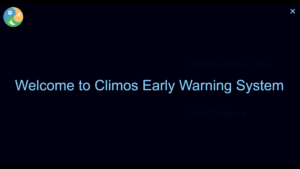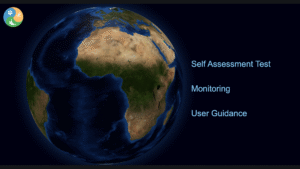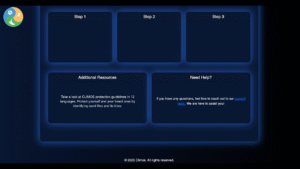The crucial role of Early Warning Systems (EWS) in Public Health management, and adaptation for sand fly-transmitted diseases
Climate change is dramatically altering the landscape of infectious diseases, particularly those transmitted by vectors like sand flies, mosquitoes, and ticks. In the CLIMOS project we focus on sand flies, as they are particularly susceptible to climate variations leading to shifts in their geographical range and survival across different regions.
We aim to establish an Early Warning System for sand fly-triggered health infections and diseases, which would include predictive models, interactive maps for risk management and adaptation cost and benefit assessments.
The impact of Climate Change on sand flies and their expanding territories
Unlike some insects, such as mosquitoes, which have developed robust mechanisms for winter survival, sand flies lack these adaptations and do not survive harsh winter conditions. The disruptive impact of climate change on temperature patterns, causing milder winters and altered seasonal temperatures, extend sand flies’ geographical reach to new regions and prompt earlier, intensified sand fly activity.
The geographical shifts of sand flies have implications for the transmission of diseases they carry, such as Leishmania parasites and Phleboviruses. As sand flies extend their geographical range, they introduce diseases to new areas, increasing the risk of disease transmission to both humans and animals in regions that were previously considered disease-free. Sand flies that were previously confined to Mediterranean countries can now be found in more northern regions, like central and eastern Europe and Turkey.

@J. SADLOVA/CUNI/CLIMOS
Early Warning Systems for sand fly-transmitted diseases: a lifesaving approach in public health management, risk assessment and cost-benefit adaptation
At the heart of the CLIMOS project lies the development of Early Warning System (EWS), a pivotal component that offers stakeholders, including One Health professionals and the general public, the ability to visualize sand fly data. This comprehensive view is made possible through sensors, coupled with prediction models. The EWS incorporates these elements into an interactive map, providing valuable insights into sand fly distribution and risks in the different regions.
The CLIMOS EWS closely aligns with the United Nations Office for Disaster Risk Reduction (UNDRR) definition of an EWS, which views it as an integrated system encompassing hazard monitoring, forecasting, disaster risk assessment, communication, and preparedness activities. This integrated approach empowers individuals, communities, governments, businesses, and others to take timely action, reducing disaster risks ahead of hazardous events.
In this sense, UNDRR identifies four pillars that guide EWS development which are fully aligned with CLIMOS activities: disaster risk knowledge, detection and monitoring of hazards, warning dissemination and communication, and preparedness to respond.
Furthermore, this alignment incorporates principles from risk management, as defined by the Intergovernmental Panel on Climate Change (IPCC). Risk management involves plans, strategies, and policies to mitigate the likelihood and magnitude of potential adverse consequences. It emphasizes that risk encompasses the potential for adverse outcomes, acknowledging the inherent element of uncertainty.

In this context, CLIMOS’ EWS addresses “sand fly risk” by providing information not only about changes in sand fly presence but also about other risk components, as defined in the IPCC risk framework:
- Hazard: likelihood of adverse events, natural or human-induced that can negatively affect vulnerable and exposed elements. In CLIMOS, this primarily relates to the density of sand flies in specific areas.
- Exposure: encompasses the elements in an area where hazard events may occur, with a focus on the human or animal population in specific regions.
- Vulnerability: pertains to the propensity of exposed elements, such as people, their livelihoods, and assets, to suffer adverse effects when impacted by hazard events.
CLIMOS EWS considers three different time horizons in the risk and/or hazard forecast:
- Short range: forecast for the next few days. This type of forecast is usually deterministic.
- Medium-term: forecasts for the next month which are often presented as ‘tercile probabilities’ (above normal, normal, or below normal).
- Long-term: projections by using climate models and greenhouse gas emission scenarios allow us to quantify a hazard –and its uncertainty- in the next decades.
Positive impact of the EWS on Public Health
The CLIMOS project’s early warning systems have a positive and far-reaching impact on public health. They empower communities to be better prepared, mitigate risks, and reduce the impact of sand fly-transmitted diseases in the context of a changing climate. This proactive approach not only saves lives but also contributes to more effective resource allocation and sustainable disease prevention efforts:
- One Health Approach: The CLIMOS project’s focus on early warning systems encompasses human health, animal health, and the environment. This holistic “One Health” approach acknowledges the interconnectedness of these factors and aims to protect not only humans but also animals and ecosystems.
- Timely Intervention: EWS help inform the public and healthcare authorities about potential disease outbreaks and empower them to take preventive measures promptly. They can distribute preventive resources and raise awareness.
- Policy Development: Decision-makers can use the data provided by early warning systems to formulate policies aimed at tackling the evolving challenges posed by climate change and vector-borne diseases.
- Timely Access to Information: The public gains access to timely and relevant information about sand fly-related health risks and diseases. This information empowers individuals and communities to make informed decisions and take necessary precautions.
- Resource Allocation: Precise information from EWS enables efficient allocation of healthcare resources. This ensures that affected communities receive the necessary medical support promptly.
- Community Engagement: Awareness campaigns and public outreach efforts informed by early warnings encourage communities to engage in disease prevention. This fosters a sense of shared responsibility and encourages community members to take actions that protect themselves and their neighbours.
- Risk Reduction: By providing information about risks associated with sand flies and vector-borne diseases, the public can take steps to reduce their exposure and vulnerability, leading to fewer adverse health consequences



